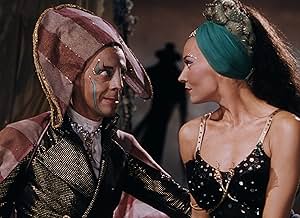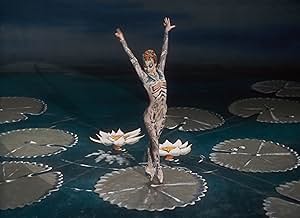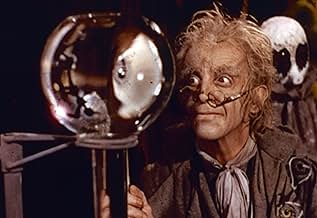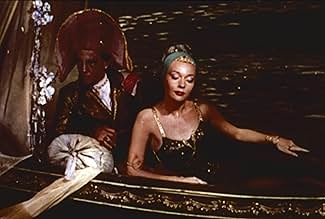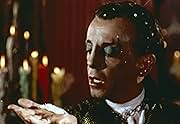Un poeta melancólico reflexiona sobre tres mujeres a las que amó y perdió en el pasado: una muñeca mecánica, una cortesana veneciana y la hija tuberculosa de un célebre compositor.Un poeta melancólico reflexiona sobre tres mujeres a las que amó y perdió en el pasado: una muñeca mecánica, una cortesana veneciana y la hija tuberculosa de un célebre compositor.Un poeta melancólico reflexiona sobre tres mujeres a las que amó y perdió en el pasado: una muñeca mecánica, una cortesana veneciana y la hija tuberculosa de un célebre compositor.
- Dirección
- Guionistas
- Elenco
- Nominado a 2 premios Óscar
- 2 premios ganados y 3 nominaciones en total
- Giulietta
- (as Ludmilla Tcherina)
- …
- Spalanzani
- (as Leonide Massine)
- …
- Olympia
- (doblaje en canto)
- …
- Giulietta
- (doblaje en canto)
- …
- Nicklaus
- (doblaje en canto)
- …
- Antonia's Mother
- (doblaje en canto)
- Spalanzani
- (doblaje en canto)
- …
Opiniones destacadas
On first viewing, my reaction to it was mixed: it's impossible not to be impressed by the visuals (particularly the stylization of Hein Heckroth's colorful and imaginative designs) but, since I'm no expert in classical music, I wasn't bowled over by Jacques Offenbach's score (apart from the celebrated "Barcarolle" piece) - especially since the lyrics, despite being an English translation, aren't easily followed! However, listening to it with the Audio Commentary, I could better appreciate the way it was made and the special effects that were adopted; especially interesting was the fact that it was filmed silent, thus allowing freer camera movement. The main cast, apart from Pamela Brown, is made up of ballet performers and opera singers - with the former, mostly recruits from THE RED SHOES, carrying the more compelling screen presence.
The framing story - featuring an additional ballet composed by the film's conductor Sir Thomas Beecham - is a bit short, so that we mostly learn about the characters played by Robert Rounseville (as Hoffmann) and Robert Helpmann through their various guises in the former's three tales (which are themselves variable in quality):
i) the "Olympia" sequence, highlighting Moira Shearer and Leonide Massine, is overlong but quite charming; Helpmann's distinctive features are rather buried under some quaint make-up - though his violent destruction of Shearer (who plays a doll) makes for a quite unsettling moment!
ii) "Giulietta" is the best and most interesting sequence, but also the shortest: Ludmilla Tcherina is a very sensuous heroine, while Helpmann and Massine are wonderful (and wonderfully made up) as respectively an evil magician and a (literally) soulless officer under both their spell; this sequence features some incredible imagery - like Tcherina's reflection in water picking up the aria she is singing, her walking over sculptures of dead bodies, Rounseville and Massine's saber duel set to music (i.e. presented without any sound effects) and the scene in which Rounseville loses his reflection when tempted in front of a mirror by Tcherina
iii) the "Antonia" sequence is again too long (it was severely cut in the original U.S. theatrical release) and, because it's mostly straight opera, emerges as the most labored segment: Massine is pretty much wasted here, while Ann Ayars is nowhere near as captivating as Shearer or Tcherina; however, Helpmann's belated entrance as the satanic Dr. Miracle takes the sequence to another level, and especially memorable here is the scene where Ayars exits a room only to re-enter it from another door (which must have inspired a similar incident in Mario Bava's KILL, BABY, KILL! [1966]) and the one where Ayars and Helpmann's dancing figures are divided into four to fill up the entire screen - with the latter taking each of his guises in the different segments and, likewise, the former being replaced with the heroines of each tale (Moira Shearer appears twice here as she also plays Stella, Hoffmann's love interest in the framing story!)
The Archers' films are among my favorites - though I was somewhat underwhelmed by I KNOW WHERE I'M GOING! (1945; I still haven't purchased the Criterion SE), THE BATTLE OF THE RIVER PLATE (1956; amazingly, both of my two attempts to view it in the past have only managed to put me to sleep!) and, now, THE TALES OF HOFFMANN. I've yet to watch 4 of their collaborations - CONTRABAND (1940; I've been tempted, time and again, to buy Kino's bare-bones DVD but the over-inflated price always got in the way!), THE ELUSIVE PIMPERNEL (1950), GONE TO EARTH (1950; this troubled production isn't likely to see the light of day on R1 DVD anytime soon, but is at least available via a budget-priced R2 edition), and their last 'musical' together OH, ROSALINDA! (1955). I would also like to watch Powell's solo films HONEYMOON (1959) and BLUEBEARD'S CASTLE (1964), which are yet two more musically-oriented ventures.
The story begins in Nuremberg as Hoffmann watches the object of his affections, Stella (Moira Shearer) dance a ballet. During the intermission, he goes into a tavern and tells the customers about his three major affairs.
Opera singers, with two exceptions, dub the stars, who are mostly from the ballet world; several will be familiar from The Red Shoes: Moira Shearer, Ludmilla Tcherina, Robert Helpmann, Léonide Massine, and Frederick Ashton. Only Hoffmann, Robert Rounsville, and Antonia, Anne Ayars, do their own singing. The rest of the vocals are provided by Dorothy Bond, Margherita Grandi, Monica Sinclair, Joan Alexander, Grahame Clifford, Bruce Dargavel, Murray Dickie, Owen Brannigan, Fisher Morgan, and Rene Soames.
Both the singing and dancing are absolutely magnificent, the beautiful Shearer dancing much better than she did in The Red Shoes several years earlier, and Powell and Pressburger fill the opera with fantastic effects and colors. My favorite is Shearer's doll ballet sequence, with the glorious coloratura singing of the Doll Aria by Dorothy Bond, a discovery of Sir Thomas Beecham, who conducts the orchestra. Tragically she was killed in a car accident the next year; she deserved to be one of the most famous sopranos who ever lived.
There are a couple of problems with this incredible piece. It's done in English, which due to the tamber of the high soprano voice, can make it difficult to understand. So people who know the opera would probably enjoy it the most. Secondly, it's not paced very well - there are some very draggy sections; some of the chorus work could have been cut.
The overall effect for the eyes and ears is fabulous, but "The Tales of Hoffmann" leaves one depressed for how far we've fallen culturally in this world. Imagine mounting this film today. How many people would attend? Five?
¿Sabías que…?
- TriviaGeorge A. Romero, writer/director of La noche de los muertos (1968) and El amanecer de los muertos vivientes (1978) has cited this as his all-time favorite movie, saying that it was the one that originally inspired him to get into filmmaking.
- ErroresGiulietta's necklace is turned from jewels to wax by Dapertutto, however, in a longer shot, it is briefly shown as jewels again, before a close-up, where it is wax again until Dapertutto changes it back to jewels.
- Citas
Chorus of Students: Some drink, drink, drink, drink, drink: do you hear us about? You lazy lout! We want some beer; we want some wine! Pour out the wine, and drink and drink till morning. Pour out the wine for drinking is divine. It is divine. We want some beer; we want some wine. We want some beer; we want some wine.
- Créditos curiososIn the end credits, main actors appear taking curtain calls next to the singers who dubbed them.
- Versiones alternativasThe complete 138-minute version was available in 16mm black and white early television prints. The complete 138-minute version was also available in 16mm Kodachrome (color) rental prints. The complete 138-minute soundtrack was available for many years on LP (London Records).
- ConexionesFeatured in The Late Show: Michael Powell (1992)
- Bandas sonorasThe Tales of Hoffmann, A Fantastic Opera
Music by Jacques Offenbach
Arranged by Thomas Beecham (uncredited)
English libretto by Dennis Arundell
From the French text by Jules Barbier
Conductor: Thomas Beecham (as Sir Thomas Beecham Bart.) with The Royal Philharmonic Orchestra
Sung by Robert Rounseville, Dorothy Bond, Margherita Grandi, Ann Ayars (as Ann Ayars), Monica Sinclair, Joan Alexander, Grahame Clifford, Bruce Dargavel, Murray Dickie, Owen Brannigan, Fisher Morgan, Rene Soames, and The Sadler's Wells Chorus
Selecciones populares
Detalles
- Fecha de lanzamiento
- País de origen
- Idioma
- También se conoce como
- The Tales of Hoffmann
- Locaciones de filmación
- Productoras
- Ver más créditos de la compañía en IMDbPro
Taquilla
- Total en EE. UU. y Canadá
- USD 91,930
- Fin de semana de estreno en EE. UU. y Canadá
- USD 23,340
- 15 mar 2015
- Total a nivel mundial
- USD 140,714
- Tiempo de ejecución2 horas 13 minutos
- Relación de aspecto
- 1.37 : 1
Contribuir a esta página




